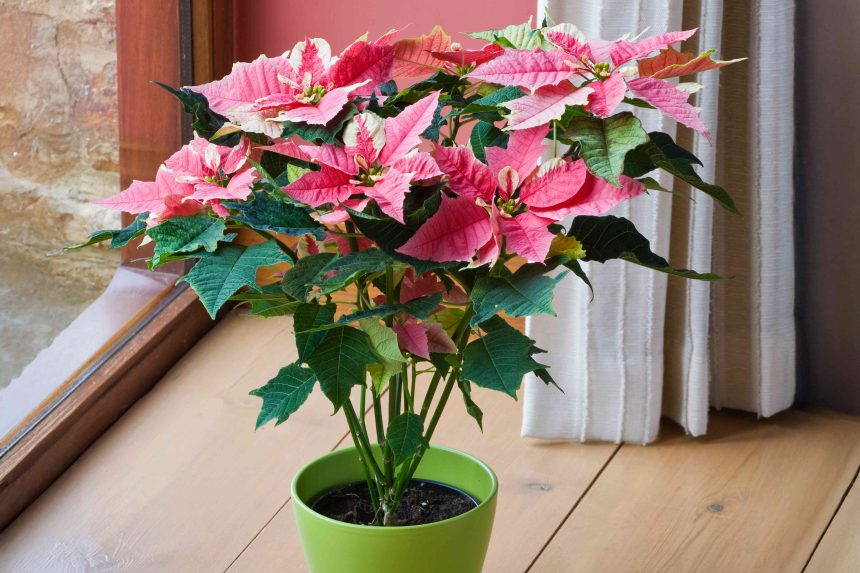No plant is quite as synonymous with Christmas and the holiday season as the poinsettia. The bold red flowers and large green leaves make any space look instantly festive. When your poinsettia starts wilting and turning brown, however, it doesn’t exactly scream “holiday cheer.” So, if your plant is showing signs of distress, we’re here to help. Experts told us the main reasons a poinsettia might be dying—and gave us advice for how to revive it.
Initial Signs Something Is Wrong
If you want to keep your poinsettia healthy throughout the holiday season (and beyond), then be sure to pay attention to any changes in the plant’s appearance. Here are some common warning signs that something is wrong with your poinsettia plant:
- Leaves are turning yellow or curling at the edges
- Leaves are browning at the edges
- Leaves are wilting or drooping
- Premature leaf dropping
- Leggy plant growth
“These symptoms are usually a sign of stress, often due to an issue with watering, lighting, or temperature conditions,” says Andrew Connolly, founder of Little Flower Cottage, a gardening and flower blog.
“While these signs can be subtle, it is essential that you catch them early,” says Donna Letier, the co-founder and CEO of Gardenuity. “Happy plants tell you when they’re thriving, and these early signs let you know when your plants need a little extra love.”
Reasons Your Poinsettia Is Dying
Underwatering
If the leaves of your poinsettia are wilting, crispy, and turning brown—and the soil feels dry—those are clear signs that it’s in need of more water. To remedy this, Letier says to water your plant thoroughly, and be sure to let the excess water drain out so it isn’t sitting in water.
To keep your plant from being parched in the future, make sure to keep an eye on the soil. “Check the soil moisture regularly and water when the top inch feels dry,” Connolly says.
If just the edges of your plant’s leaves are brown, Letier says this often means the air is too dry. “Consider misting the plant or placing a humidifier nearby,” she recommends.
Overwatering
If your plant’s leaves are yellowing or falling off, the roots might be waterlogged, Letier says. Be sure to empty the saucer or tray under the poinsettia, and let the soil dry out slightly before watering it again. Using well-draining soil will also help to keep the plant from getting waterlogged in the future.
Drooping or wilting leaves, while it may look like a sign of underwatering, could also be a sign of root rot due to overwatering, Letier says. So, if this is the case, make sure to check the soil moisture before watering your plant again.
Drafts
Even though poinsettias are commonly associated with wintertime, the plants love warmth. “If they’re near a drafty window or door, the leaves can brown or drop,” Letier says.
“Maintain stable temperatures between 65–75 degrees Fahrenheit and place the plant near bright, indirect sunlight,” Connolly recommends. “Avoid moving it to colder or darker spots.”
To keep the plant in a steady temperature range, be sure to keep it away from doors, windows, or heaters. “Poinsettias are sensitive to drafts, cold temperatures, and sudden environmental changes,” Letier says. “Keep them in a warm, stable spot.”
Heat Stress
While warm areas are generally a good spot for poinsettias—too much heat can also be a problem. “Too much direct sunlight or heat from a vent can cause leaf burn,” Letier says. “Indirect, bright light is best.”
Too Little Light
Finding a balanced, stable spot for your poinsettia is key. If your plant looks leggy, weak, sparse, or like it’s stretching out, it’s likely not getting enough light. This means your plant needs to move closer to a bright window or light source. Still, be sure to avoid direct sun, as this can cause leaf burn and heat stress.
How to Know When Your Poinsettia Is Beyond Repair
We have hope that your poinsettia can still be saved, but it’s good to know when your efforts might not be worth it. “If the plant’s stems are mushy, black, or rotting at the base, that’s a clear sign of severe root rot or fungal infection,” Connolly says. “Unfortunately, at that point, it’s very likely the plant will be beyond saving. A healthy root system is white or light tan; if the roots are dark and foul smelling, there’s little chance the plant can recover.” So, if that’s your plant’s case, it’s probably best to just get rid of it. But there’s no rule that says you can’t replace it with a new, healthy one and try again.




